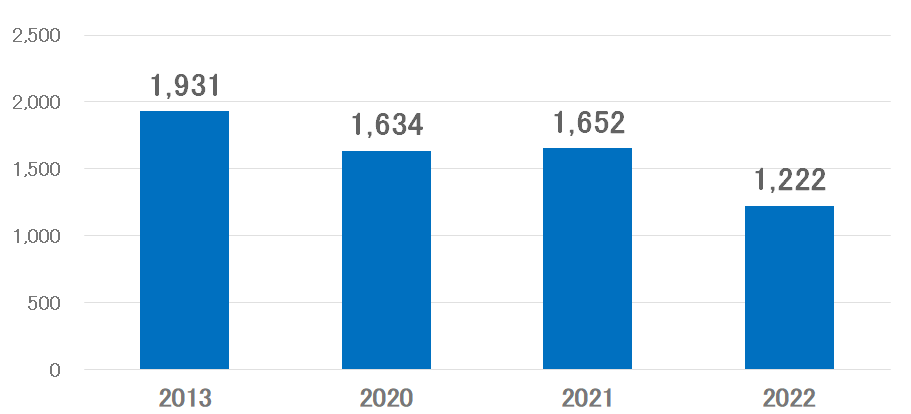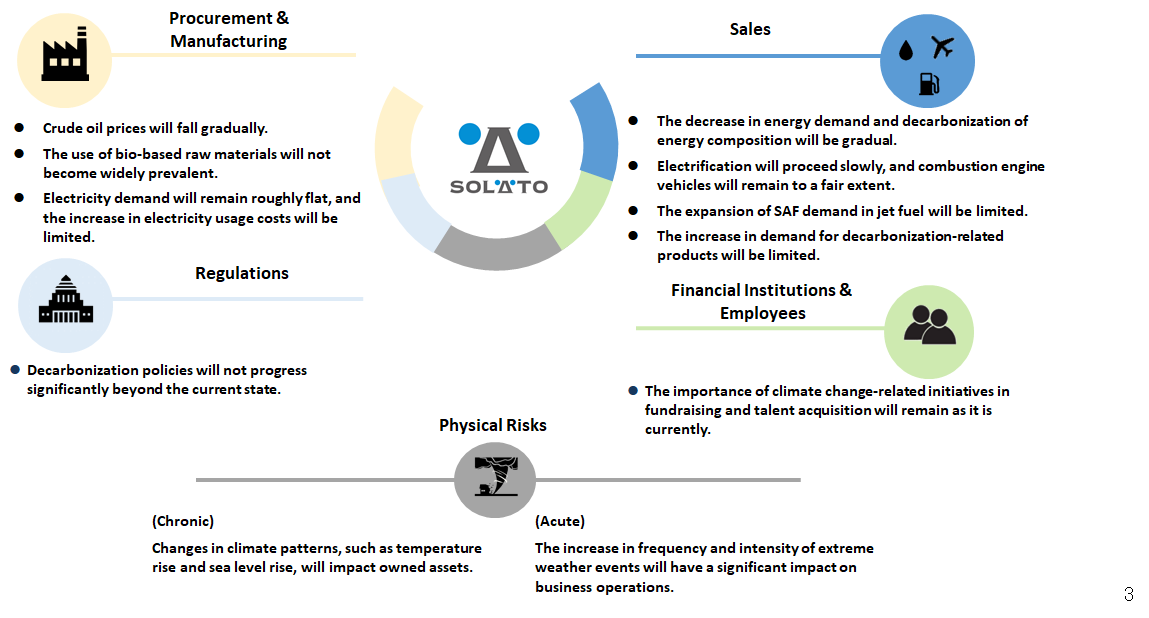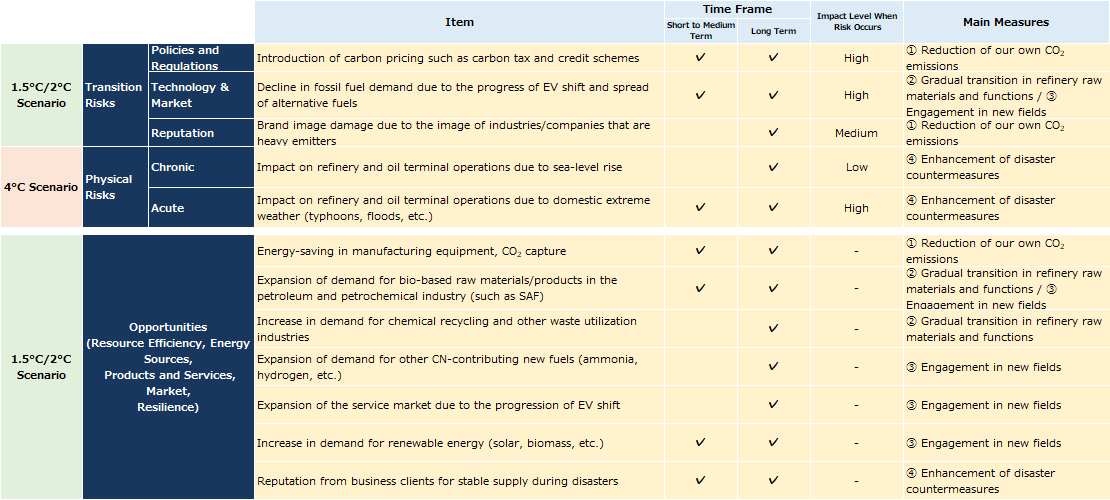Information regarding the TCFD
Basic Concept/Strategy
-
In recent years, as the progression of climate change accelerates the movement toward the realization of a decarbonized society, the role expected of the energy industry is significant and continues to expand year by year.
-
Taiyo Oil upholds the corporate philosophy of “Like the beaming sun,” and as an integrated energy company, we aim to harmonize with the global environment, providing safety and security, and contribute to the creation of an enriched society. Under this philosophy, we believe it is necessary for our group to promote management that incorporates the perspective of climate change for sustainable development into the future. Therefore, we have conducted an analysis based on the recommendations of the TCFD, and we will disclose the following information.
-
Going forward, we will continue to recognize the business environment surrounding our group, deepen our analysis of risks and opportunities, leverage this analysis in our business strategies, and further promote initiatives toward the realization of a Carbon Neutral (CN) society.
-
The TCFD issued recommendations suggest explaining the resilience of a company’s strategy based on a review of various climate change scenarios. Our company, considering the acceleration of initiatives toward a decarbonized society, has analyzed two scenarios: one where the increase in global temperatures is limited to 1.5℃/2℃ above pre-industrial levels, and another where no further measures are taken beyond the current state, leading to a global temperature rise of 4℃.
In setting the scenarios, we have referred to scenarios published by the International Energy Agency (IEA) and the Intergovernmental Panel on Climate Change (IPCC).The outline of each worldview and the reference scenarios are as follows (mainly assuming domestic trends).
Strategy - Climate Change Scenario
Worldview of the 1.5℃/2℃ Scenario
* Main reference scenarios: IEA World Energy Outlook, 2023 Announced Pledges Scenario (which aligns with the goals of the Paris Agreement), Net Zero Emissions by 2050 Scenario (which aims for the achievement of net zero emissions), and IPCC Sixth Assessment Report SSP1-2.6
Worldview of the 4℃ Scenario
* Main reference scenarios: IEA World Energy Outlook, 2023 Announced Pledges Scenario (which aligns with the goals of the Paris Agreement), Net Zero Emissions by 2050 Scenario (which aims for the achievement of net zero emissions), and IPCC Sixth Assessment Report SSP1-2.6
Strategy - Risks and Opportunities
Based on the above scenarios, we have organized the climate change-related risks and opportunities envisioned by our group as follows.
For clarity in capturing risks and opportunities, we considered transition risks and opportunities in the context of the 1.5℃/2℃ scenario, and physical risks in the context of the 4℃ scenario, each scenario highlighting the respective risks and opportunities more prominently.
* The analysis targets Taiyo Oil Co., Ltd., Taiyo Oil Sales Co., Ltd., and Nansei Sekiyu K.K.
* Time frame: Short to medium-term → from now until 2030; Long-term → from 2030 to 2050
* Impact level: The impact on our group's businesses is comprehensively considered and rated on a three-tier scale: high, medium, low
Strategy - Main Measures
- The impact of climate change on our business is critical for our group, which is currently primarily engaged in petroleum refining and marketing, due to the decline in demand for fossil fuels that is expected to proceed rapidly under the 1.5℃/2℃ scenario, and the simultaneous shift to alternative fuels, and we recognize the need for appropriate risk management and capturing opportunities.
-
Our group will address the risks and opportunities identified in this analysis with a focus on four main directions:
① Reduction of our own CO2 emissions,
② Gradual transition in refinery raw materials and functions,
③ Engagement in new fields, and
④ Strengthening disaster countermeasures.
The details and current status of each initiative are as follows:
① Reduction of our own CO2 emissions
We will promote energy conservation at our manufacturing facilities and promote CCS surveys and studies to reduce CO2 emissions.
Additionally, we will participate in councils for the introduction and utilization of fuel ammonia and advance the study of transitioning to CN fuels in manufacturing facilities and in-house power generation.
▶ Establishment of the "Council for the Introduction and Utilization of Fuel Ammonia through the Namikata Terminal as a Hub"
② Gradual transition in refinery raw materials and functions
Bearing in mind the mission of our group to maintain a stable supply of energy, we will consider a gradual shift of refinery raw materials and functions to supply products made from biomass and waste plastics, for which demand is expected to grow in the future, and strive to optimize our portfolio.
In promoting the supply of products using woody biomass and waste tires as raw materials, we believe it is important to create new supply chains through collaboration with various stakeholders, and we are exploring different forms of partnerships. We will also promote initiatives with an awareness of value creation unique to our Group, which aims to "coexist in harmony with local communities".
▶ Taiyo Oil will begin joint study of first green refinery project in Japan to utilize forest resources
▶ Initiating a joint study of cracking discarded tires into oil as a chemical recycling business
③ Engagement in new fields
With the transition to a CN society, new demands are expected to arise in areas such as SAF, synthetic fuels, hydrogen, ammonia, renewable energy, EV-related services, etc. We will seize these opportunities while also assessing compatibility with our existing management resources, including refineries and service stations.
Additionally, our group company Nansei Sekiyu has begun considering the manufacture and supply of SAF, aiming to start supply in the latter half of the 2020s, and we will continue to explore becoming a supply hub for new energies like hydrogen and ammonia, which can utilize existing infrastructure.
▶ Start of Operations of SDT Solar Power Co., Ltd. Solar Power Plant
▶ Taiyo Oil launches SOLATO Carshare demonstration experiment in which vehicles run on solar power
④ Enhancement of disaster countermeasures
To fulfill our duty of stable energy supply even in the event of disasters, we are promoting disaster countermeasures based on our internally developed disaster prevention business plans. In response to abnormal weather conditions such as wind and flood damage, we are working on various measures for disaster prevention and mitigation, including the introduction of disaster prevention equipment, strengthening disaster countermeasures for existing facilities, and establishing response systems for times of disaster.
In addition, to continue the supply of petroleum products during disasters, we have formulated a business continuity plan (BCP), regularly conduct drills assuming damage to refineries and oil terminals, and work on identifying issues and reviewing operations.
In the future, we will continue to update and monitor information related to this analysis, advance the sophistication of analysis of the impact on business, and promote countermeasures more effectively to further strengthen resilience.
Metrics and mesures
- Taiyo Oil has set the following goals for climate change measures.
* The goals apply to Taiyo Oil Co., Ltd., Taiyo Oil Sales Co., Ltd., and Nansei Sekiyu K.K.
▶ Our vision for 2050
Aim for net-zero CO2 emissions associated with our business activities (Carbon Neutral).
▶ CO2 reduction target for 2030
Aim for reduction CO2 emissions associated with our business activities by 30% compared to FY2013.
- Actual CO2 emissions for FY2022 were 1,222 thousand tons for Scope 1&2, and 15,426 thousand tons for Scope 3.
-

Scope1&2 CO2emission thousand tons
Governance and risk management
- We utilize the Management Meeting and the Compliance & Risk Management Committee (CR Committee, chaired by the President & CEO) to regularly discuss our company’s risks, including those related to climate change, and to manage responses appropriately.
- The CR Committee conducts a company-wide risk assessment once a year, discussing the impact on our business of risks, including climate change, identified by the company’s departments and major subsidiaries, and determining the key risks for the entire company.
- Among the identified climate change-related risks, business strategy-related issues are deliberated on at management meetings, where progress reports on each measure are presented approximately twice a year. For the physical aspects, such as disaster countermeasures, the CR Committee reviews the response plans and reports progress approximately twice a year, and important measures are deliberated at management meetings.
- Items discussed and reported at management meetings are reported to the Board of Directors meeting, ensuring appropriate supervision by the Board of Directors meeting.


